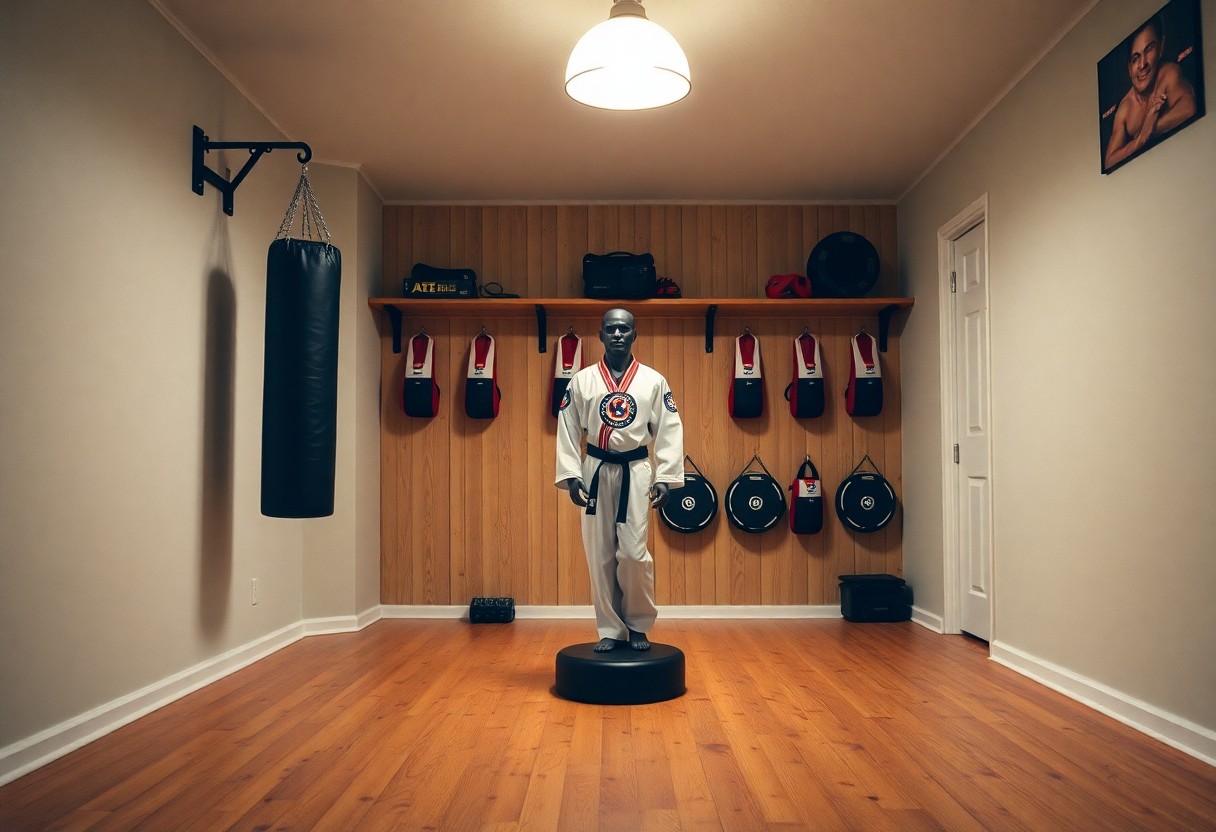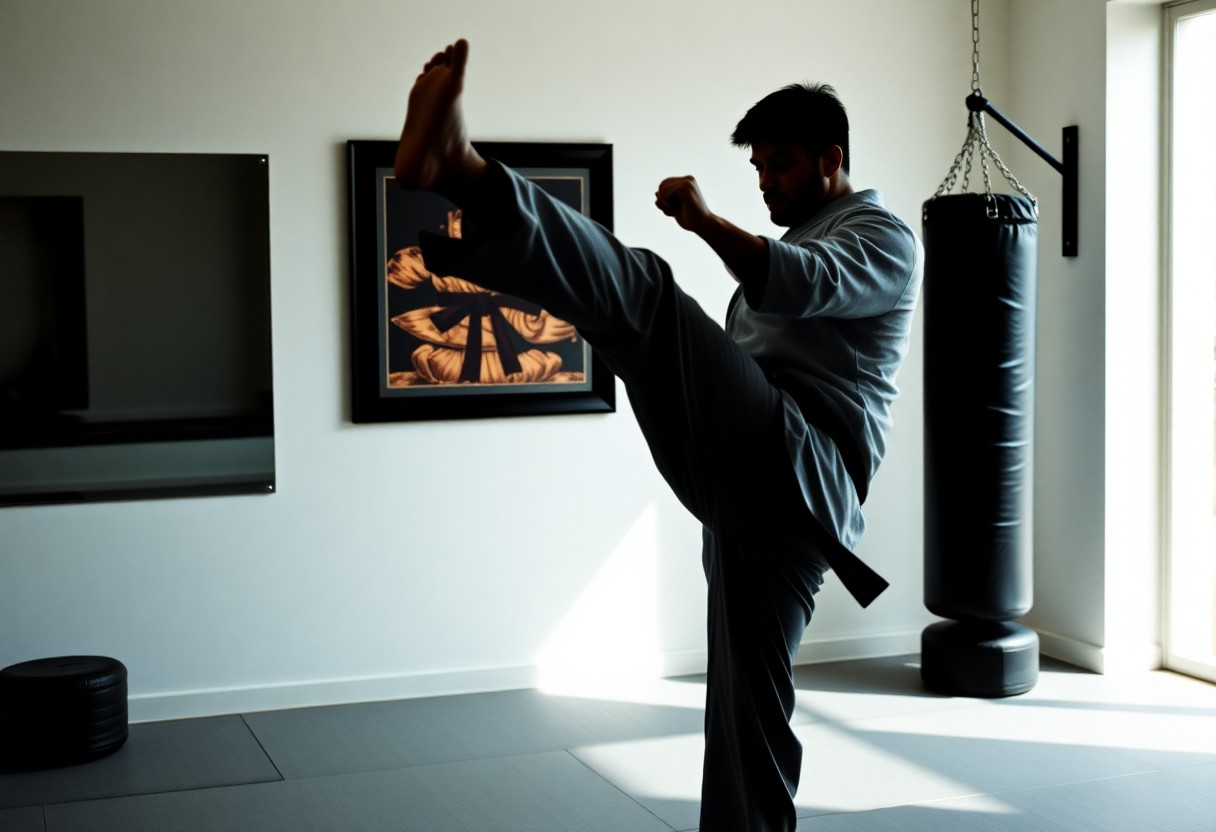You can develop consistent Taekwondo discipline right from the comfort of your home. In this post, I’ll share practical strategies and techniques that I have personally used to enhance my training routine. By incorporating these methods, you can establish a focused mindset and stay committed to your Taekwondo journey. Whether you’re a beginner or a seasoned practitioner, you’ll find valuable insights that will help you stay disciplined and motivated in your practice.

Crafting Your Home Training Environment
Creating an ideal training environment at home enhances your practice and helps maintain focus. A designated area for training should be free from distractions and equipped with all necessary tools, supporting your discipline and motivation. Consider transforming a spare room, garage, or even a corner of your living space to cultivate an ambiance conducive to Taekwondo practice. Proper lighting, flooring, and ventilation play a role, but personal touches like inspirational posters can also make a significant difference.
Designing a Dedicated Training Space
Your chosen space should cater to the movements and techniques you’ll be practicing. Ensure that it’s spacious enough to execute kicks, stances, and forms without the risk of injury or damage to surrounding objects. Clear any clutter, and if possible, invest in mats to cushion falls. Using mirrors can also aid in checking your form, helping you refine techniques on your own.
Essential Equipment and Gear for Taekwondo
Equipping your training space with vital Taekwondo gear increases the effectiveness of your practice. At a minimum, invest in a good-quality dobok (uniform), protective gear like shin guards, and a heavy bag for physical conditioning. These items help simulate a realistic training experience, enabling you to focus on techniques and physical conditioning safely.
The right equipment is vital for a comprehensive training routine. In addition to the basic uniform and protective gear, consider acquiring a striking pad or focus mitts, ideal for working on precision and power in your kicks. Resistance bands can enhance strength training, while a jump rope can improve your cardiovascular fitness. A quality heavy bag lets you practice striking techniques and build muscle memory. Tailoring the equipment to your training goals will make a notable difference in your journey toward mastery.
Establishing a Structured Training Regimen
Developing a structured training regimen is vital for cultivating consistent discipline in Taekwondo. Allocate specific times in your day for practice, integrating both technique and physical conditioning. This consistency will help you build momentum and create a training cycle that incorporates various aspects of Taekwondo—from forms and sparring drills to strength and flexibility exercises. Having a schedule allows for focused training sessions that not only keep you disciplined but also ensures you progress effectively towards your martial arts goals.
Daily Routines: Balancing Technique and Conditioning
Your daily routines should strike a balance between technique practice and conditioning work. Incorporating a mix of both will enhance your skills while improving your overall fitness. For instance, set aside 30 minutes for practicing your forms or kicks, followed by 30 minutes dedicated to strength and flexibility workouts. Including specific drills like shadow sparring or bag work helps maintain dynamic movements while expanding your knowledge and execution of techniques.
Goal Setting: Short-term vs. Long-term Objectives
Setting both short-term and long-term objectives is vital for maintaining focus and motivation in your Taekwondo training. Short-term goals, such as mastering a specific kick or increasing the number of push-ups you can do, provide immediate targets and instant gratification. Long-term objectives, on the other hand, might include earning a higher belt rank or preparing for competitions. These two types of goals work together, allowing you to celebrate small victories along the journey while keeping your eyes on more significant achievements.
Establishing a clear distinction between short-term and long-term goals is vital for balanced progress. Short-term goals should be specific, measurable, and achievable within days or weeks, like attaining a new form or achieving a certain number of kicks in a minute. Contrastingly, long-term goals—like earning a black belt—should align with your aspiration for mastery. Regularly assessing your progress towards both types of goals helps maintain motivation and allows you to adjust your training plan, ensuring that each step contributes meaningfully to your overarching journey in Taekwondo.
Cultivating Mental Discipline Through Mindfulness
Incorporating mindfulness practices into your Taekwondo routine fosters mental discipline and enhances your overall performance. By being present in each moment and focusing on your movements and intentions, you can cultivate a deeper connection with your body and technique. Mindfulness allows for better emotional control, enabling you to respond to challenges with clarity and confidence, ultimately elevating your practice from a physical endeavor to a balanced mind-body experience.
The Role of Visualization in Performance Enhancement
Visualization serves as a powerful tool for improving your skills and confidence in Taekwondo. By mentally rehearsing techniques and sparring scenarios, I find that I can anticipate and execute moves more effectively during actual practice. This technique strengthens my neural pathways, making the muscle memory associated with these actions more intuitive. Many elite athletes utilize visualization techniques to enhance their performance, showcasing its effectiveness in competitive environments.
Incorporating Meditation and Focus Techniques
Regular meditation sessions create a foundation for focus that translates seamlessly into my Taekwondo training. I dedicate time each day to quieting my mind, honing my concentration, and regulating my breathing. This practice helps me develop a sense of calm and awareness that is vital during intense training sessions, allowing me to maintain focus even when faced with distractions.
During meditation, I often integrate focus techniques such as mantra repetition or guided imagery, which assist in solidifying my mental discipline. I visualize executing my techniques with precision, feeling each movement as if it were real. Engaging in deep breathing exercises further helps to calm my mind and center my thoughts, creating a mental state that is conducive to improved performance. These moments of clarity and focus during my meditation reflect positively in my Taekwondo practice, illuminating the path toward mastery and self-discovery.
Leveraging Technology for Enhanced Learning
Integrating technology into your at-home Taekwondo training can significantly enhance your learning experience. Online platforms, apps, and video resources provide access to expert instruction and create a structured environment for your practice. Whether you are looking for tutorial videos, guided classes, or motivational tracking tools, technology bridges the gap between home training and professional guidance.
Online Resources: Finding Quality Instruction and Videos
In the vast digital landscape, finding high-quality Taekwondo instruction can be overwhelming. YouTube channels dedicated to martial arts, such as “Taekwondo Life Magazine” and “Black Belt Magazine,” offer comprehensive techniques and tips. Additionally, websites such as Virtual Martial Arts provide structured lessons that replicate classroom environments, allowing you to follow along and improve your skills effectively.
Utilizing Apps for Progress Tracking and Motivation
Apps are an excellent way to stay motivated and track your progress while training at home. Platforms like “MyFitnessPal” or “Strava” can be tailored for martial arts training, allowing you to log training sessions, set goals, and monitor your advancements. Some specialized Taekwondo apps even provide challenges and community forums to connect with fellow practitioners.
Using apps not only promotes accountability but also gamifies your training experience. By setting specific goals, you can challenge yourself, such as aiming for a certain number of kicks per session or mastering new techniques. The ability to log your daily progress offers a satisfying visual of your improvements over time, fostering a sense of achievement. Engaging with community features allows for a support system that keeps you motivated while receiving or giving advice from others on similar journeys.
Building a Supportive Community
A supportive community amplifies your motivation and commitment to Taekwondo practice at home. Surrounding yourself with fellow martial artists boosts your morale and discipline, making it easier to stay consistent. With the rise of digital connections, you can find like-minded individuals who share your passion for Taekwondo even from afar. Engaging with others fosters camaraderie and provides opportunities for knowledge exchange that enriches your training experience.
Engaging with Online Taekwondo Forums and Social Media Groups
Online forums and social media groups dedicated to Taekwondo create a vibrant space for sharing experiences, tips, and resources. Engaging with these platforms allows you to ask questions, seek advice, and learn new techniques from practitioners worldwide. For instance, participating in exchanges about specific forms or sparring strategies can enhance your understanding and keep you engaged in the discipline, no matter your skill level.
Organizing Virtual Training Partners or Accountability Buddies
Finding virtual training partners can dramatically improve your home training routine. Connecting with a partner eliminates isolation and introduces an element of accountability. Scheduling regular video sessions for practice or sparring can keep your motivation high and ensure you remain consistent. Consider using video chat platforms to share your techniques, receive immediate feedback, and adjust your training together.
To effectively organize virtual training partners or accountability buddies, I recommend creating a small group of dedicated practitioners via social media or online forums. You can schedule regular meetings, set goals for each session, and hold each other accountable for progress. Try using applications like Zoom or Google Meet for structured training sessions, where you can practice forms together, analyze each other’s performances, or even participate in friendly competitions. This interactive approach not only keeps your training fresh but also builds lasting friendships within the Taekwondo community.
To wrap up
With these considerations, I believe you can effectively train consistent Taekwondo discipline at home. Establishing a structured routine, setting clear goals, and incorporating a variety of drills can keep your practice engaging and productive. I encourage you to stay focused and committed, as your progress will reflect your dedication. Utilize resources like instructional videos and connect with other practitioners online to boost your motivation. By cultivating a disciplined mindset, you will not only enhance your Taekwondo skills but also foster personal growth and resilience in other areas of your life.
FAQ
Q: What are some effective ways to create a training space at home for Taekwondo practice?
A: To create an effective training space for Taekwondo at home, start by finding a quiet area with enough room for movement. Use mats or carpeting to ensure a safe surface for kicks and falls. You can also hang a mirror to monitor your form and a bag for practicing strikes. Make sure the space is well-lit and free from distractions. Designate a specific time for practice to help establish a routine and maintain focus during training sessions.
Q: How can I stay motivated to train consistently at home without the presence of an instructor?
A: Staying motivated while training at home can be challenging. Set clear, attainable goals to work towards, such as mastering a specific kick or technique. Recording your progress can also help visualize improvements and serve as motivation. Joining online classes or virtual training sessions can provide structure and community support. Additionally, consider incorporating Taekwondo-themed challenges or competitions with friends or fellow practitioners to keep the training engaging and fun.
Q: What drills can I incorporate into my home training routine to improve my Taekwondo discipline?
A: To enhance your discipline in Taekwondo at home, focus on a mix of physical and technical drills. Shadow fighting is excellent for practicing techniques and footwork without equipment. Incorporate bag workouts for power and precision, and consider flexibility drills like stretching or yoga to enhance your range of motion. Practicing forms and katas will help solidify technique and improve discipline. Lastly, including strength training exercises, such as bodyweight workouts, can aid in building the stamina needed for effective practice.

